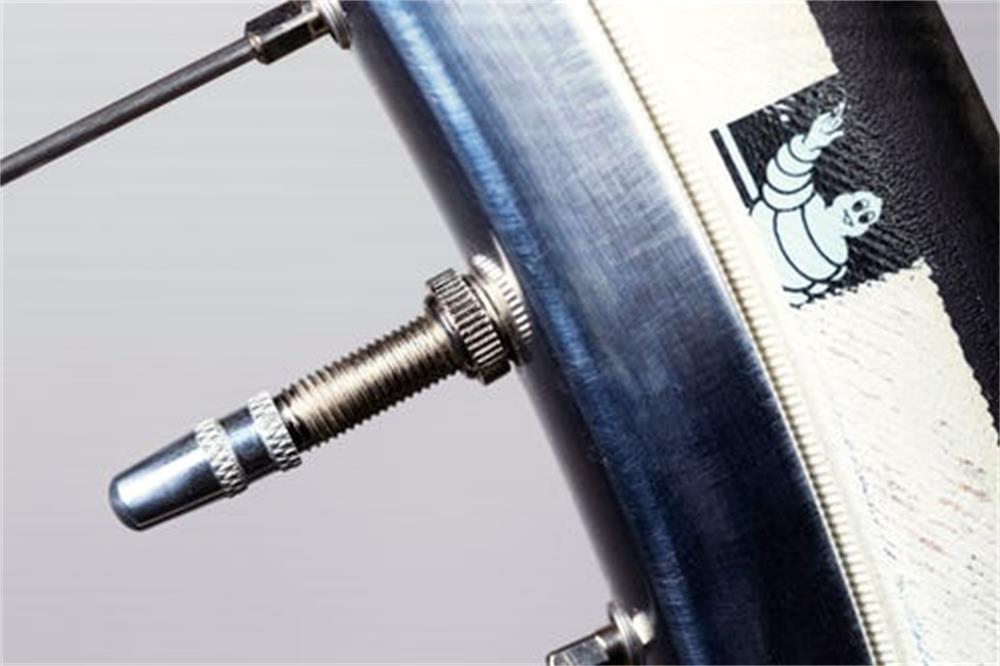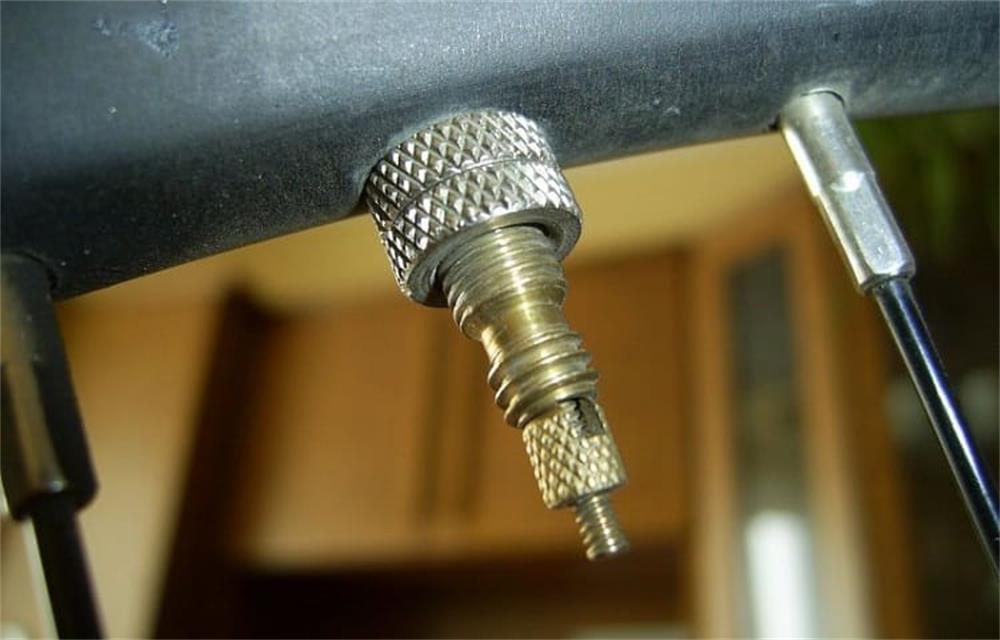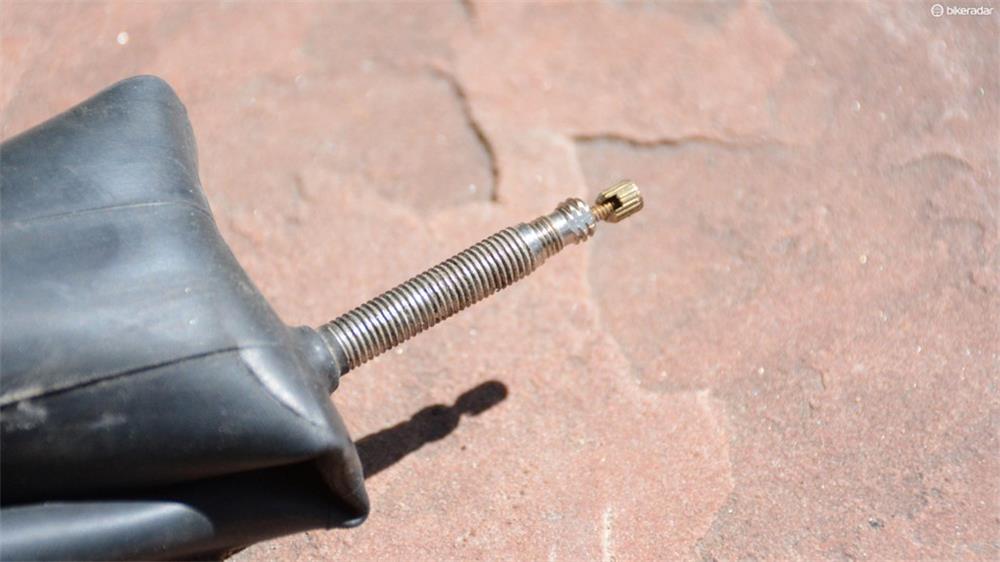Presta Valves: Pros and Cons

This guide outlines the main differences between the two valve types. I’ll also list the pros and cons of Presta valves to help you choose the type of valve that best suits your riding style.
What is a Presta valve?
Presta valves are longer and narrower than Schrader valves. The stem is made entirely of metal and runs from top to bottom. The valve tapers towards the top. Presta valves usually have a locknut that secures the valve stem to the rim. There is usually no lid on the top.
The Presta valve has a removable inner core that screws into the valve stem. There is a small lock nut on top of the spool that keeps the valve closed when tightened. There are no internal springs. When the lock nut is loosened, the pressure in the Presta valve tube keeps the valve closed.
Presta valves are a bit more complicated to use than Schrader valves. To get air through the valve, you have to loosen the small lock nut on the top. You have to be careful not to loosen it too much so that the nut doesn’t come off. You can then push down on the inner pin to open the valve. With the valve open, you can deflate, deflate, or check tire pressure. When you release pressure from the pin, the air pressure in the tube immediately closes the valve. Then tighten the top lock nut to prevent the valve from opening or leaking.
Presta valves are used almost exclusively on bicycles. They can be used with tubed and tubeless tires. Manufacturers typically install Presta valves on road bikes, gravel bikes, and high-end mountain bikes. Presta valves are sometimes referred to as French valves or Sclaverand valves.
What is the difference between Presta and Schrader valves?
Both valves serve the same purpose. They allow you to put air in and out of the tube. They both have a valve stem that goes through the rim and a valve core that controls airflow.
The biggest difference is the size of the valve. Schrader valves are larger in diameter than Presta valves. The American valve is 8mm in diameter, while the Presta valve is 6mm in diameter.
Presta valves are a bit longer than Schrader valves. The standard American nozzle valve is 32mm in length. Presta valves are available in lengths ranging from 32, 42, 48 and 60 mm.
The mechanism that keeps the valve closed is also different. A spring keeps the American valve closed. The lock nut keeps the Presta valve closed. The spools for both valve types are generally removable and replaceable. This may come in handy if the valve starts leaking or gets stuck with sealant. Some models of both valve types do not have replaceable spools.
The Presta valve has a locking ring that secures the valve to the rim. American valves do not have this feature. Most American style valves have a cap, while Presta valves usually do not.
As for the bike, the only difference between wheels designed for Shrader valves and those designed for Presta valves is the size of the valve holes drilled into the rim. American style valves require larger holes than Presta valves because of their larger diameter.

Advantages of Presta Valves
The wheel is stronger when you use Perst valves – the valve hole creates a weak point in the rim. Because the Presta valve is narrower than the Schrader valve, the valve orifice is smaller. Smaller valve holes leave a few extra millimeters of material on the rim. This extra material helps keep the wheel strong. In other words, Presta valves have less impact on the structural integrity of the rim than American valves. It doesn’t make much of a difference for wide mountain bike rims. For narrow rims, having smaller valve holes helps make the wheel stronger. Stronger wheels are more durable. It will also last longer. If your rim accepts tires smaller than 28mm, you should use Presta valves.
Presta valves allow for narrower rims – some road rims are so narrow that Schrader valves can’t fit between the tire’s beads. This is often the case with race cars that use clincher tires. The Presta valve is narrow enough to fit between the beads. If you have extremely narrow tires, you will need to use Presta valves.
Presta Valves Available in Different Valve Lengths – Presta Valves are available in a range of lengths including 32, 40, 48, 60 and 80 mm. If you use deeper rims, such as carbon fiber aero rims, you will need longer valves. The valve needs to go from the rim bed to the other side of the rim. The American-style mouth valve is only 32mm long. If your bike has deep rims, these will be hidden and inaccessible.
The Presta valve stays straight in the rim – the lock nut on the bottom of the valve keeps the valve perpendicular to the rim. This prevents the valve from tipping. American-style mouth valves tend to bend if you install the tube slightly off center. When the valve is straight, it is less likely to be damaged by the rim. It also looks better.
Presta Valves Make Inflating Flat Tires Easier – A locknut on the base of the Presta valve secures the valve to the rim. This prevents the valve from moving up and down in the rim when the tire is deflated. Installing a pump and inflating a flat tire is much easier when the valve remains in place. When you try to connect the pump, the American nozzle valve tends to move down into the rim.
You can use an adapter to convert Presta valves to Schrader valves – if your bike has Presta valves and you don’t like them, you can install a simple converter. This also allows you to use a Schrader pump or pressure gauge on the Presta tube. This is an easy and cheap conversion. These slime valve adapters do the trick.
Presta Valves Are Easier to Inflate – When you use a Presta Valve, you don’t have to overcome the valve spring when using the pump. Pumping water requires less effort. This makes it easier to inflate high-pressure road bike tires.
You don’t lose air pressure when you stop or remove the pump – this is especially important when inflating high pressure road tires. By design, the pressure in the pipe will keep the Presta valve closed even if the top lock nut is loose. You don’t lose any air pressure when you remove the pump. With American style valves, you rely on a spring to close the valve. You almost always lose a little pressure when you stop pumping or remove the pump.
You can release pressure in a more controlled manner with just your fingers – to let air out of the Presta valve, just loosen the top lock nut and lightly depress the pin with your finger. This allows you to expel the air easily and slowly. No tools are required. This is helpful if your tires are over-inflated. You can let the air out until they reach the proper pressure. It also comes in handy if you need to lower tire pressure for extra traction when riding on loose or rough surfaces. This comes in handy when riding off-road. To get air out of the Schrader valve, you need a tool. It is also more difficult to control airflow with American style valves.
Presta Valves Are Lighter – Presta valves are several grams lighter than Schrader valves. The lighter weight reduces rolling resistance. The weight difference is minimal. You can also save weight by using a lightweight Presta pump. These simple pumps have a chuck or pump head that connects directly to the pump. No hose or valve regulator. If you carry a pump, you can save some weight with the Presta valve.
Presta valving is more common in riding—presta valving is the standard these days. Any mid-range or higher mountain or road bike will come with Presta valves from the factory. A high-end wheelset was drilled for the Presta valves. Presta tubes are more common in bike shops. Entry-level bikes usually still come with American valves.
You do not need to use a bonnet – due to the nature of the design, the Presta valve does not require a cap. They lock shut and don’t clog as easily as American style valves. This is one less part to worry about losing. You can install a cap if you want.

Presta valves may take more air pressure – road bike tires need to be inflated to 90-125 psi. Presta valves can handle these pressures without any problems. American style valves may not be able to handle this much pressure. Many cyclists have no problem running American-style valves at high pressure, even though the pressure rating may be lower. American style valves are also used in many high pressure applications. For example, aircraft tires use Schrader valves and are often inflated to over 200 psi.
Presta valves hold pressure better – I’m not sure if this is true, but many cyclists have made this claim. It is speculated that the Presta valve drops less pressure over time than the Shrader valve because the air pressure in the tube helps keep the valve closed. Personally, I don’t believe this, but I decided to put it on the list for your consideration anyway. If you have any evidence or experience with this, please comment below. As long as they are in good condition, I’ve never had a problem with either valve leaking.
Presta valves are all about high-end bikes—it’s really only about looks. If you are riding a high-end bike, you may prefer the more premium look of the Presta valve.
Presta Valve Disadvantages
Presta Valves Are More Fragile – Due to the slender design, Presta valves are more prone to rupture than Schrader valves. The lock nut can sometimes snap off the top. Sometimes the top is bent. You must be more careful when inflating the tires to avoid bending or breaking the thin tips of the valves. American style valves are more robust.
Hard to find Presta tubes and replacement parts – Tubes with Presta valves are usually only available at modern bike shops and online. You may not be able to find replacement tubes at department stores. In developing countries, Presta valves are not as common as in developed countries. In some parts of the world, Presta tubes can be hard to find, even at bike shops. This can be a problem for cyclists and bike packers who ride in rural areas or developing countries. Of course, this is not a problem if you only ride in cities in developed countries. Presta valves are standard and are available at every bike shop.
Presta valves are slightly more expensive – tubes with Presta valves tend to be a little more expensive than tubes with Shrader valves. Probably because they are considered higher end. If you do not have a Presta compatible pump, you will need to purchase one if you are switching to Preta tubing. Not all pumps are cross compatible with both valve types. If you’re on a very tight budget, the extra cost can be an issue.
You can’t use a standard car tire pump with a Presta valve – that’s one of the biggest drawbacks. Standard auto pumps are only available with American style valves. They are not compatible with Presta. That means you can’t just go to your local gas station to inflate your bike tires. You can’t use a normal air compressor. You need to have a pump that is compatible with the Presta valve. This means you need a bike pump designed specifically for Presta valves. Most modern bicycle pumps are cross compatible. If you own a bike pump, chances are it will work. If you don’t have a Presta compatible pump, you can use a Presta to Schrader converter.
Presta valves are slightly difficult to use – non-cyclists may not be familiar with Presta valves. There is a small learning curve to using them. To inflate the tire or check the pressure, you must first loosen it by turning the locknut on top of the valve counterclockwise with your fingers. Then you can connect your pump or meter. If you forget to loosen the nut, the valve will not allow air to pass. After removing the pump, you must remember to tighten the locknut down so that the valve does not open and allow air to leak. American style valves are easier to use because they have an internal spring that automatically closes them.
You can’t install Schrader tubes in rims that have been drilled for Presta valves – the holes are too narrow to accommodate them. If you want to use Schrader valves in Presta rims, you will need to drill the valve holes to make them larger. This compromises wheel strength. This is not a good idea if your bike has narrow road rims. If your bike has wider mountain bike rims, you may choose to drill larger valve holes and use Schrader valves instead. If your rims are drilled for Presta valves, it’s best to stick with them.
Some Presta spools cannot be removed – Older Presta valves do not have removable spools. This can be a problem if you want to add a puncture-resistant sealant to the pipe, if the valve gets stuck with dirt, or if the valve is damaged. You can’t just remove and replace the core. It’s worth noting that nearly all modern Presta valves have removable cores.
If you are looking for a new way of commuting or want a healthier lifestyle, we are here to help you. Visit our website to learn more about electric bikes and electric scooter or please leave information to us.
 Shuangye ebike
Shuangye ebike
